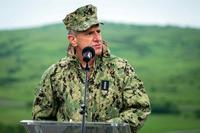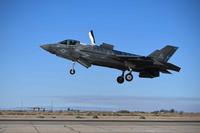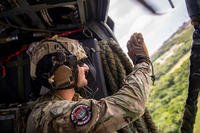The Marines were just over a hundred miles away from the southern tip of Taiwan when they seized the airstrip. They were operating in Northern Luzon and the Batanes Islands, Philippine territory north of the mainland -- key terrain for a potential conflict with China.
The mission, known as maritime key terrain security operations, or MKTSO, was practice for that conflict, but had real-world implications. It was a show of force headed by elements of the Marine Corps' newest Pacific-oriented unit: the Marine littoral regiment, or MLR.
On April 30, three combined littoral reconnaissance teams made up of roughly 30 U.S. and Philippine Marines each, flown by Army Chinooks and Black Hawk helicopters, departed a naval base off the northern coast of the mainland to insert into the remote islands.
Read Next: Army Eliminates Online Training Requirement for Noncommissioned Officers, Saying It's Too Burdensome
Their purpose was to reconnoiter the territory not only through sensors and unmanned systems but interactions with local communities, laying groundwork alongside their Filipino partners where civilian maritime trade has experienced increased aggression from China.
Those units were joined by a rifle company, also a joint-nation element, with the ability to seize and defend key terrain in the event of conflict. It was the first time that Marines with the 3rd MLR, the unit deployed to the region, went to Mavulis, which is the furthest north island of the Philippines that its military has a presence on.
"The further that we get from the mainland in order to truly demonstrate a capability, a flyaway capability that can sustain itself -- that's a significant demonstration of capabilities both on the air side and the ground side," Maj. Robert Patterson, a company commander who led forces during the air assault on one of the northernmost Philippine islands, told Military.com in an interview Monday.
The exercise marked a notch in the Marine Corps' philosophical shift after 20 years of war in the Middle East where it faced insurgent adversaries, ones less equipped and organized compared to its current "pacing challenge," China.
Lt. Col. Mark Lenzi, the battalion commander for the 3rd Littoral Combat Team, told Military.com that not only is it a shift in environment, but a recognition of the increased risk of conventional warfare.
Long-range missile strikes, loitering munitions and enhanced sensing capabilities are just "some of the things that have proliferated in the years since," Lenzi said. "You have to modify your tactics and your thinking to break the enemy's targeting cycles to avoid being detected by those weapons in the first place and then avoid being targeted by them when and if you are detected."
Lenzi is the commander of one of the MLR's critical set pieces, the littoral combat team. Within the MLR, it is accompanied by an anti-air and logistics battalion, for a total of nearly 2,000 Marines who are uniquely equipped for a Pacific fight.
That equipment includes naval strike missiles, unmanned aerial systems and radars -- assets meant to support the unit's agile, dispersed nature. Those characteristics are exemplified in missions like the MKTSO, where Marines are sent out -- alone and with only the necessary equipment they need to survive -- to remote locations in the Pacific.
"The strategic significance is the ability to put combat-capable forces anywhere that we would need them, and to deter an adversary or engage in combat without as many limitations on having to pull them back," Lenzi said.
Marines who participated in the mission brought limited supplies to the islands, a tough logistical balance that was made more difficult by the humid climate. They filled packs with water and brought along platoon water purification systems, or PWPS, a piece of equipment that can produce up to 15 gallons of water per hour from sources found in the environment.
Patterson described the water effort as "colossal," adding that fuel and food were priority items that played into his planning for the mission. The latter was in part supported by the local community. The reliance on the surrounding environment is part of the MLR's expeditionary nature.
While dispersed operations for the Marine Corps are not new, the environment is. In 2022, after the MLR was set up, it was sent to the Philippines, a country known for its multiple islands, tropical jungles and reinvigorated alliance with the U.S. in light of the threat of China, which has used its coast guard to disrupt local fishing commerce.
Now, service members find themselves constantly rotating to the country as part of the Enhanced Defense Cooperation Agreement, a plan between the U.S. and the Philippines that grants American troops access to nine Philippine military bases.
But in this case, with the MKTSO mission, Marines were sent to the farthest-reaching islands off of the Philippine coast, placing them close to Taiwan and China.
A critical part of these operations involves incorporating the Philippine military into them as a way to benefit from their knowledge of the terrain, legitimize interactions with the communities that live on the islands, and prepare for potential war together.
Those efforts were often led by Marine corporals and sergeants. It was through those squad leaders, Patterson said, that he was able to understand the community and environment based on their information and relationship-building.
"They recognized that they're some of the first United States forces on these islands," he said, specifically Itbayat, one of the islands not so far from Taiwan. "So, [they felt] very prideful, very excited to do their job."
Related: Sleepy Far-Flung Towns in the Philippines Will Host US Forces Returning to Counter China Threats













